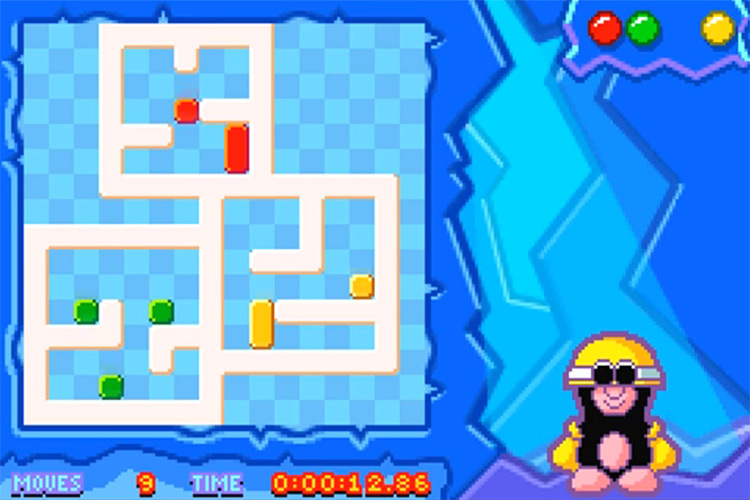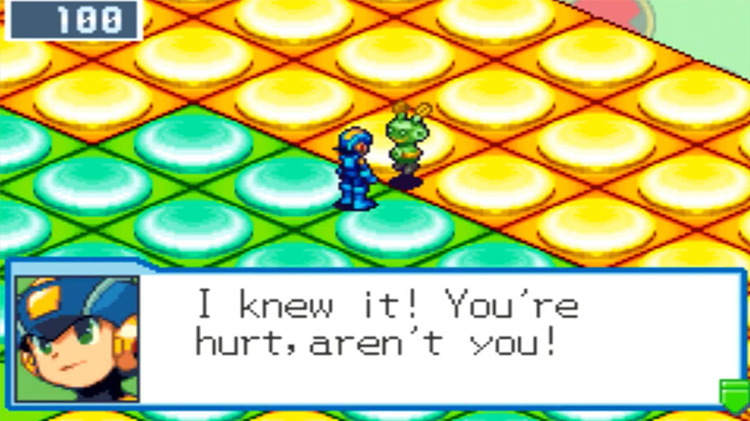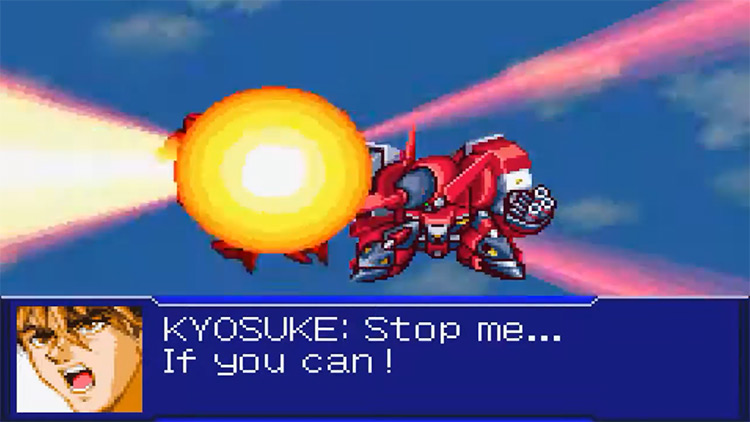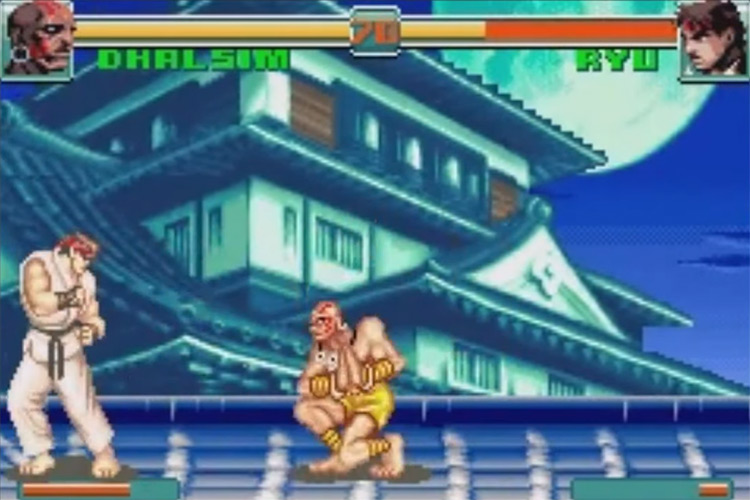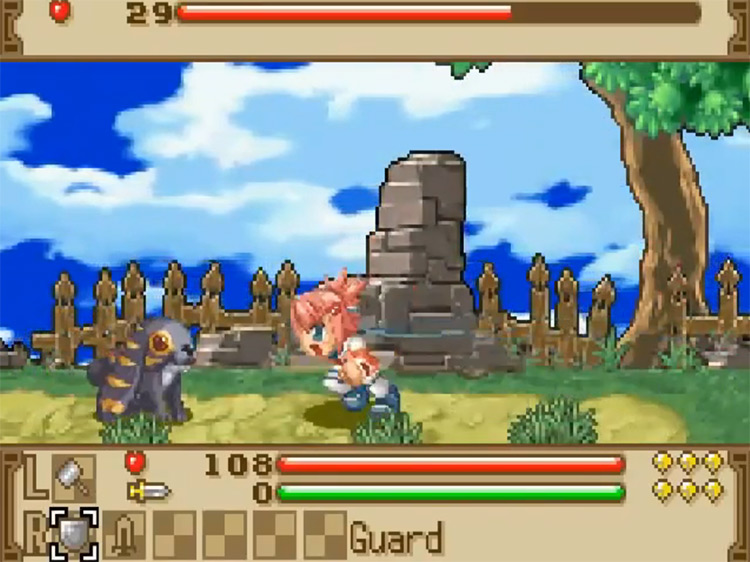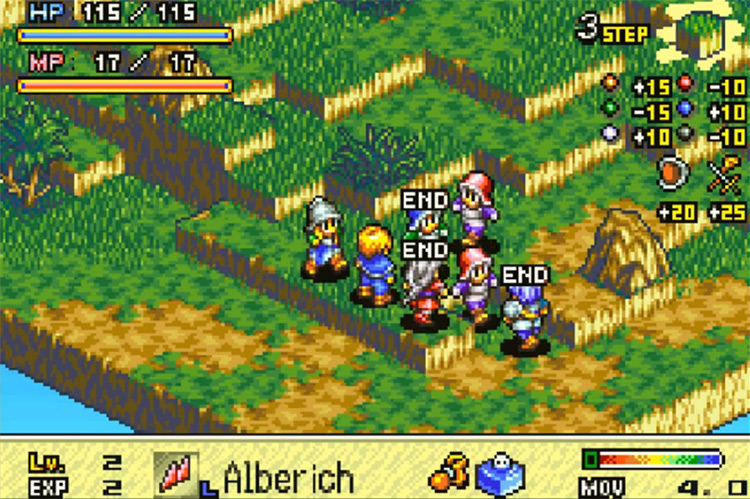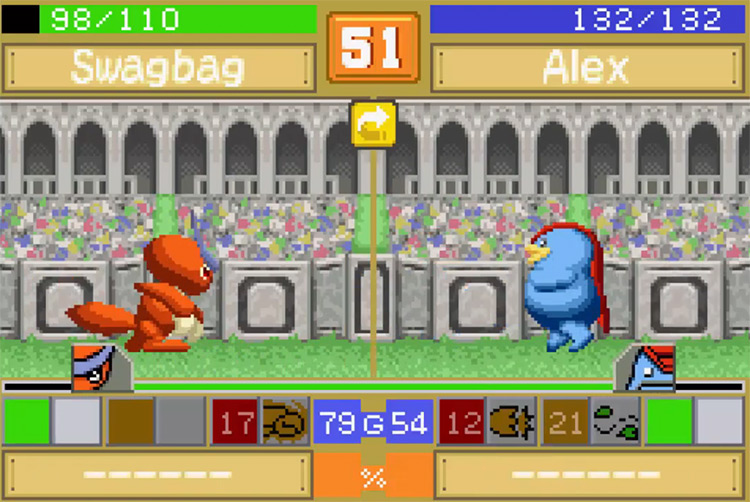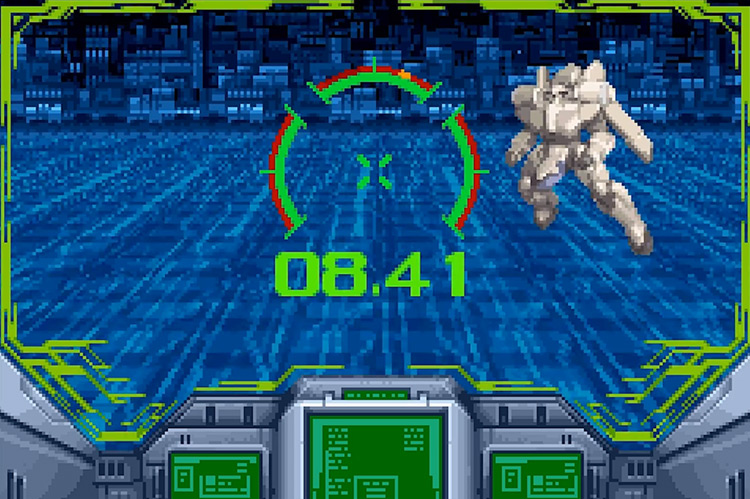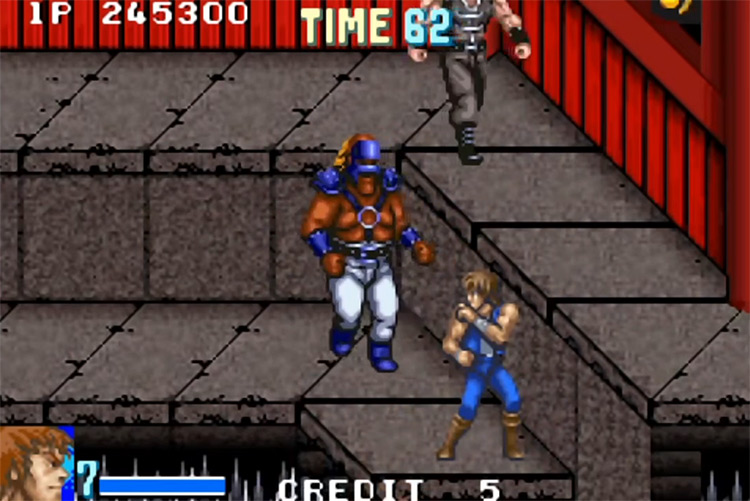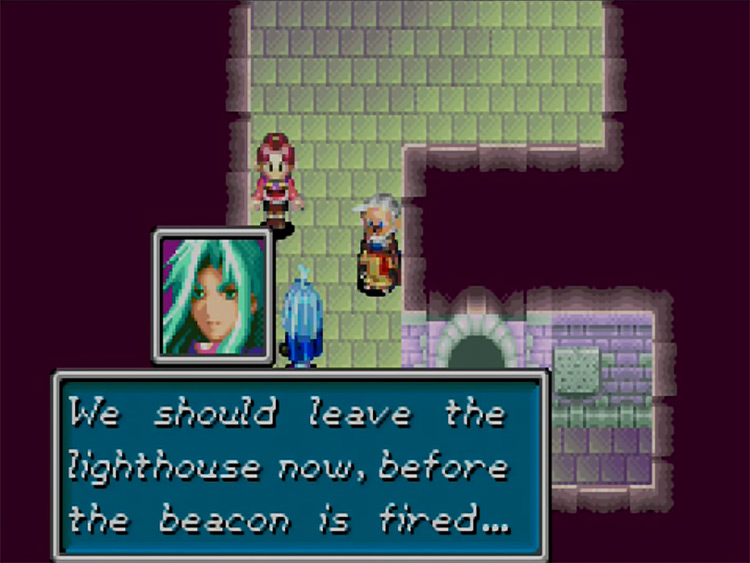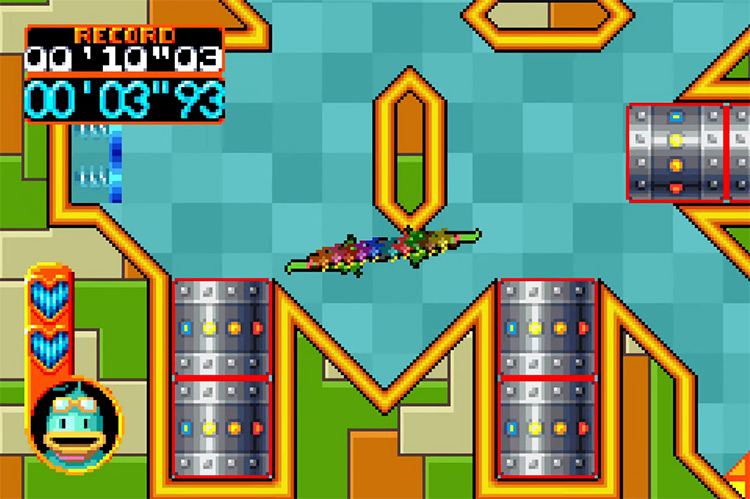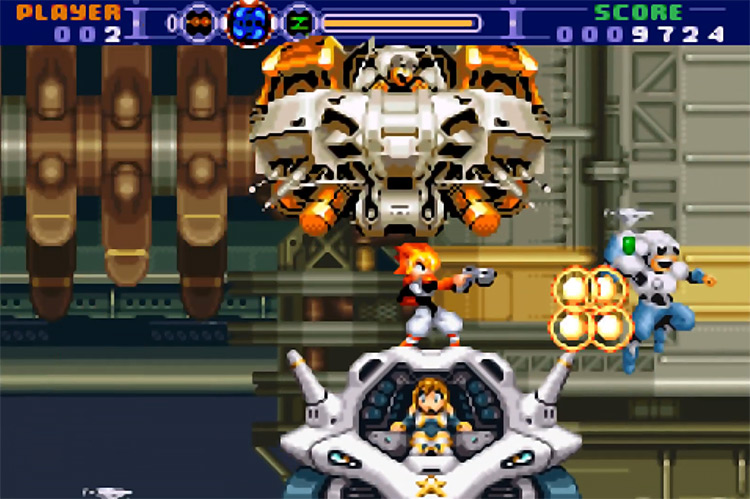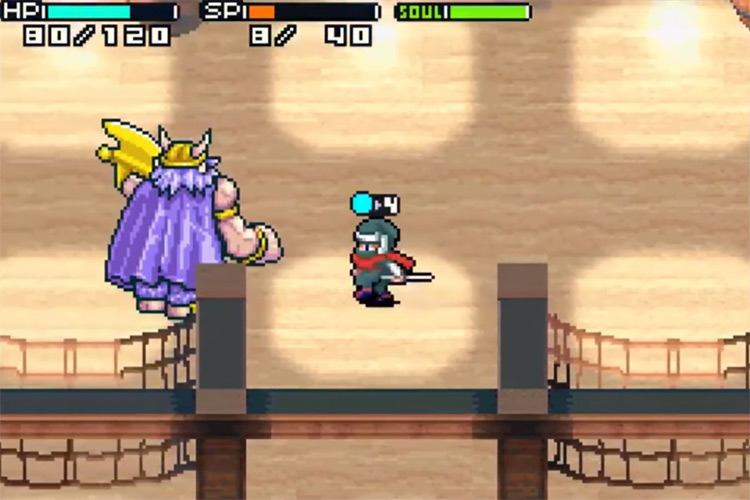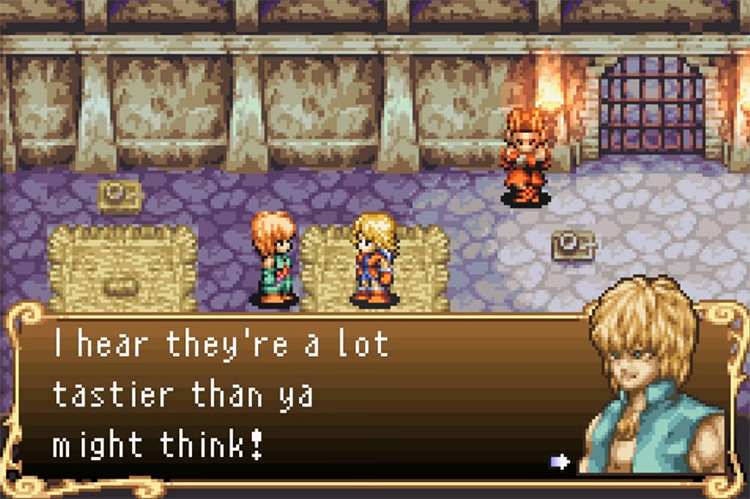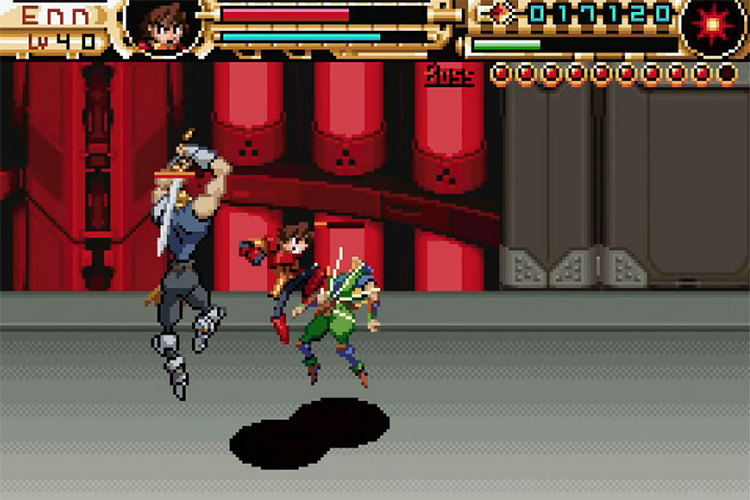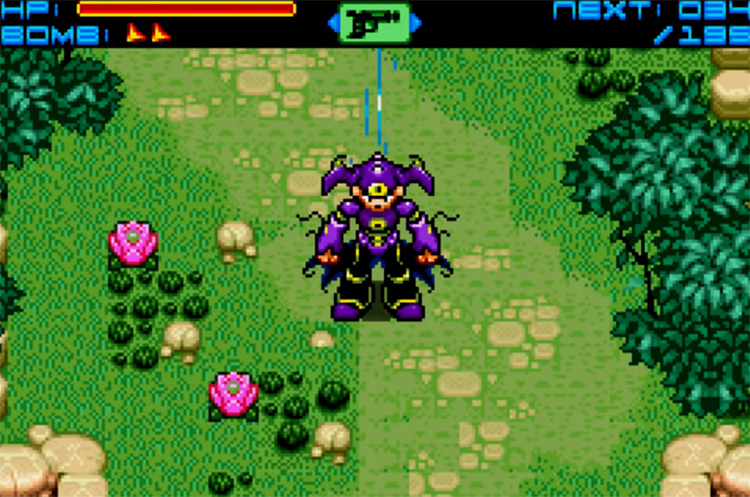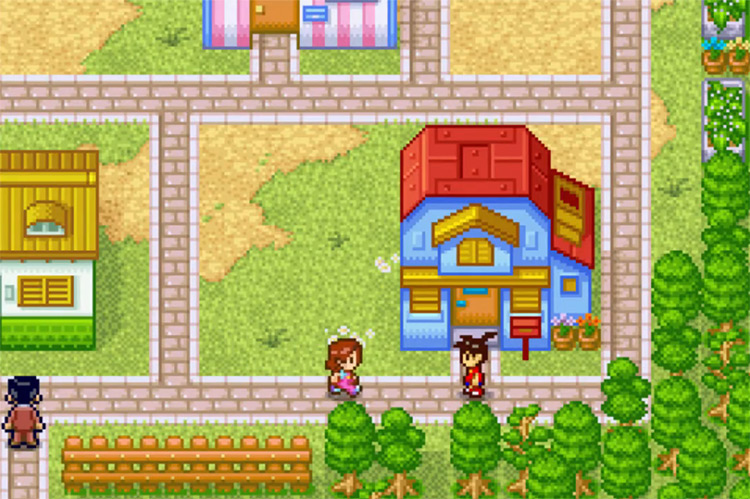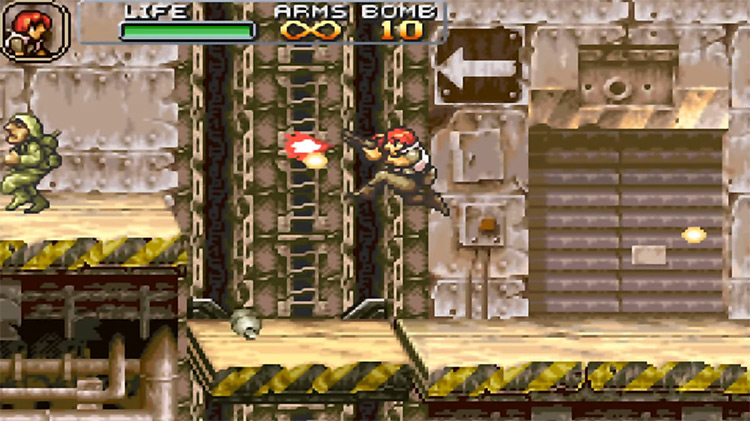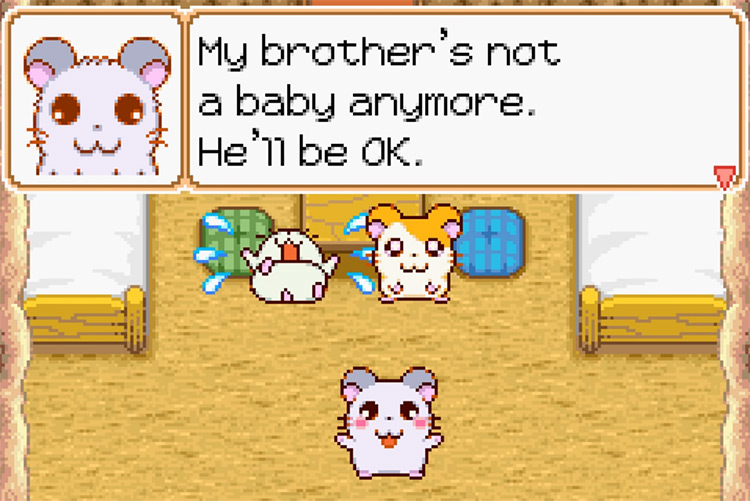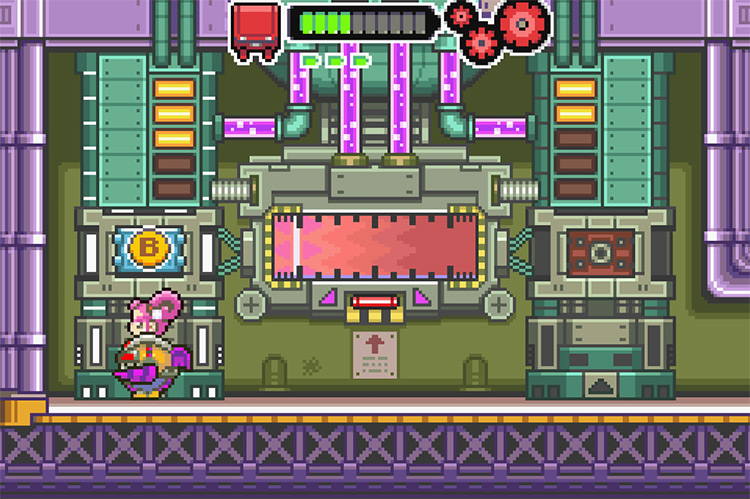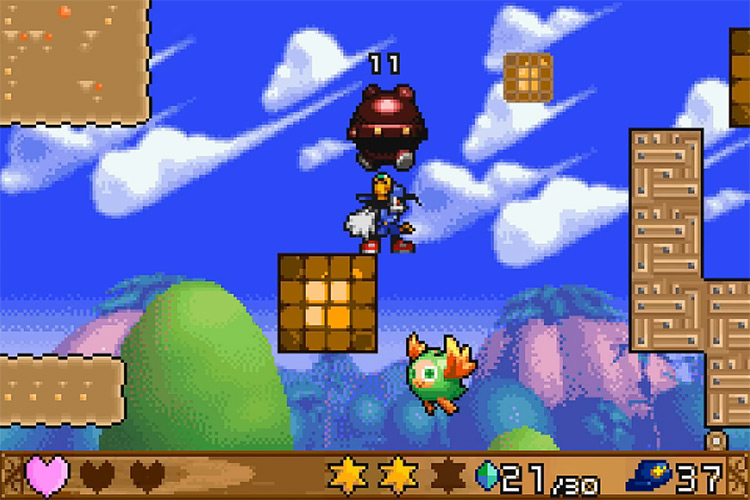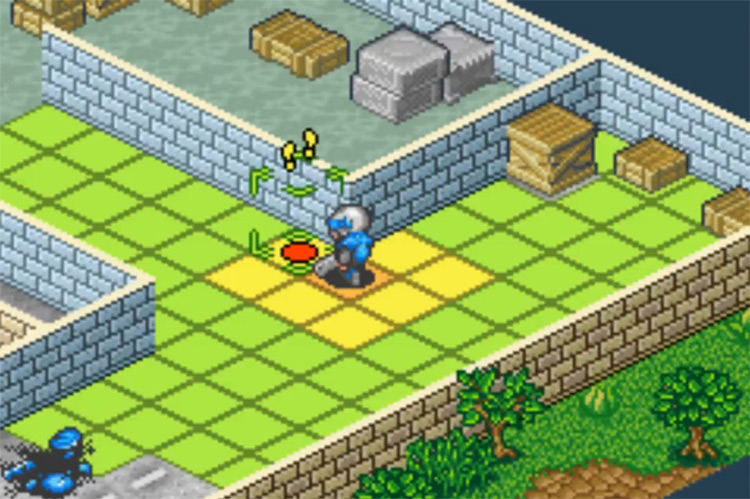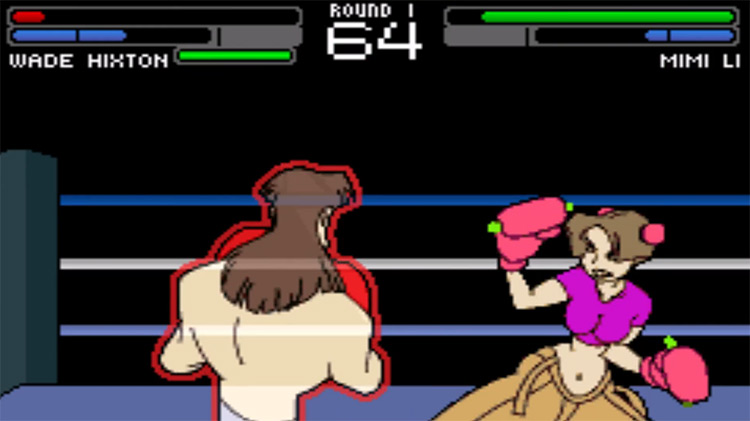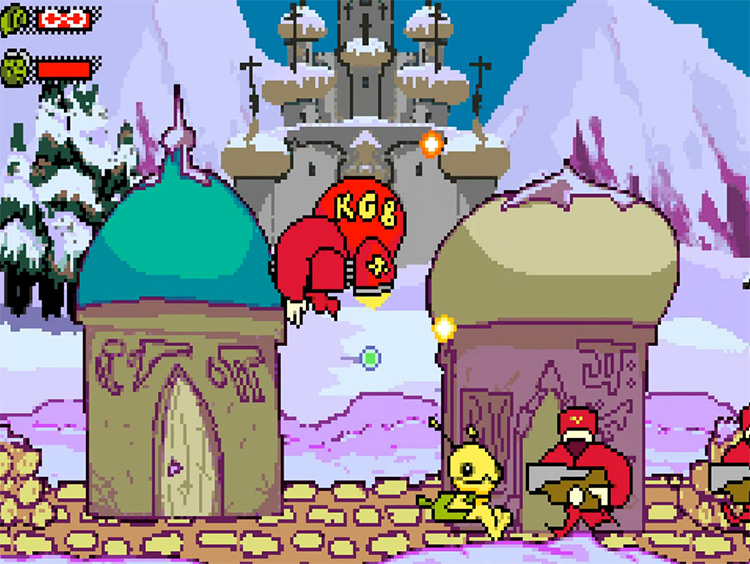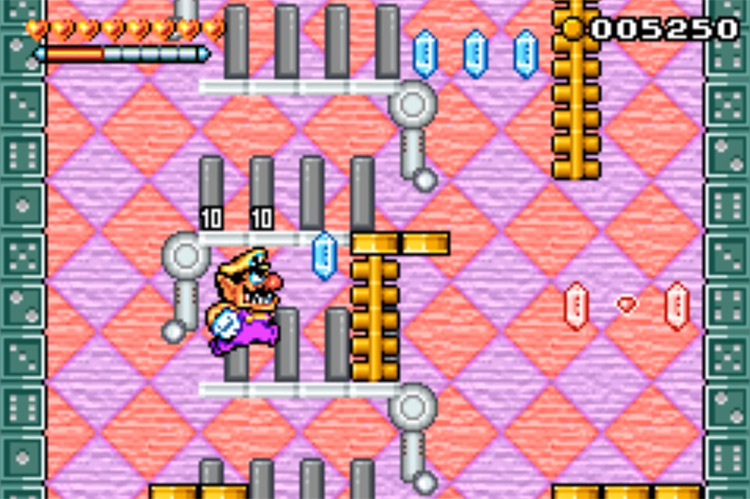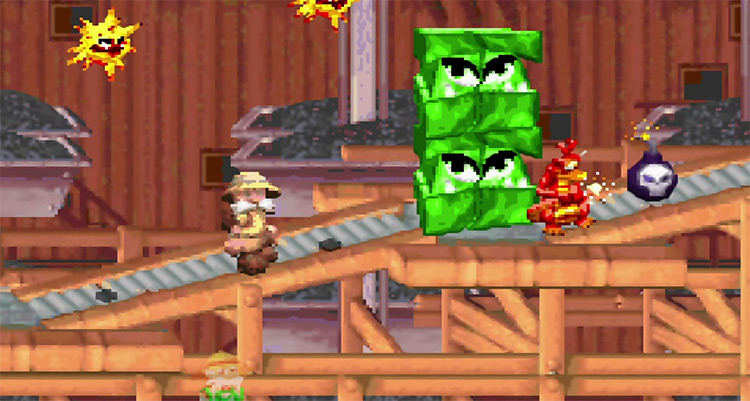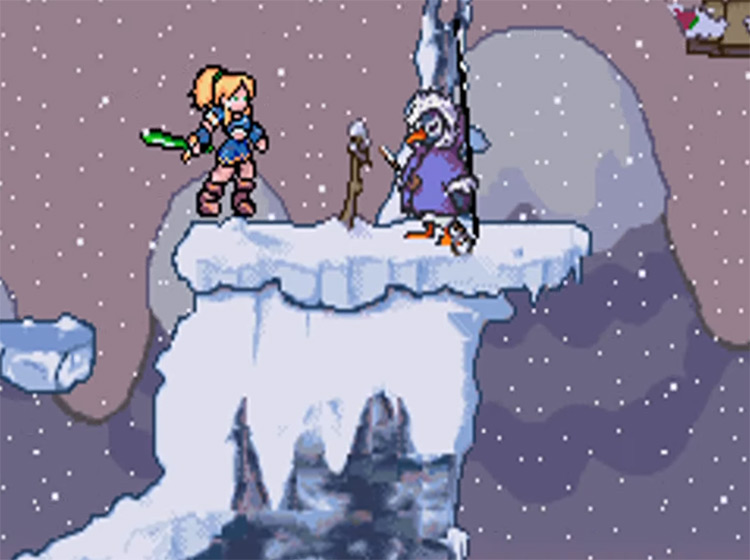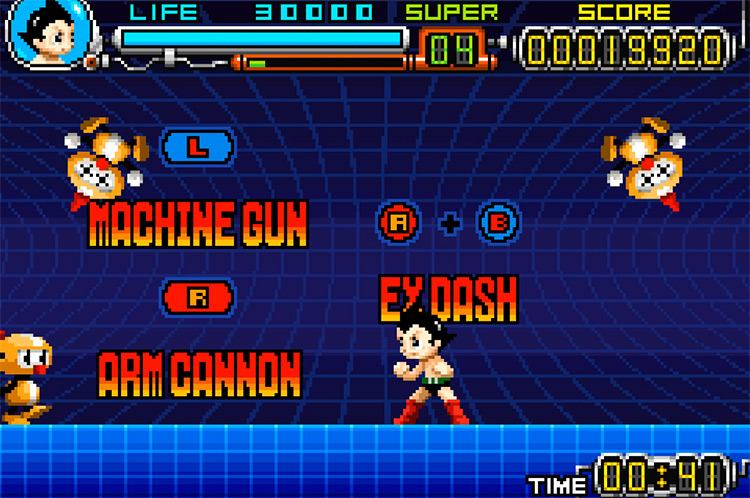Not only is the console a beauty, but it brought with it the processing power needed to put handhelds on more equal standing with home consoles. There are tons of excellent, highly regarded GBA titles like Pokémon Ruby & Sapphire (2002), Metroid Fusion (2002), and The Legend of Zelda: The Minish Cap (2004) – but there are other solid games that never achieved mainstream notoriety. Let’s take a look at some of the more under-appreciated games found on the Game Boy Advance.
30. Denki Blocks! (2002)
Puzzle fans should hunt down a copy of Denki Blocks!, an extensive collection of puzzles where you reorganize “gumblocks” around a grid board. The objective is to match same-colored blocks or create specific shapes with the available blocks. What’s so good about this puzzler is the sheer amount of content. Each of the eight champions you challenge in tournament mode will prepare 25 puzzles for you, and if you do them all correctly, you’ll unlock five more.
29. Mega Man Battle Network 4: Red Sun & Blue Moon (2004)
I loved the Mega Man Battle Network series ever since I first laid hands on it with MMBN2, considered one of the best in the franchise. On the other hand, MMBN4 is considered the weakest link for the series. If you ask me, it has a lot to do with the public being a little tired of getting more of the same every year. Look past that, and the game is actually fantastic. It does innovate a bit with stuff like Dark Chips, Soul Unisons that let you copy defeated bosses’ powers, and a ton of Boktai crossover items. This game series was ahead of its time, as shown by the rekindled popularity it enjoys in the Battle Network subreddit.
28. Super Robot Taisen: Original Generation 2 (2006)
Giant robot fans should definitely check out Super Robot Taisen: Original Generations 2, a mecha-themed SRPG with a ton of content to discover. Original Generations 2 introduces even more giant robot series into the mix, with new characters, new mechs, and story events taken straight from past Banpresto titles. The plot of the first game was already a bit nonsensical, and this isn’t much better – but it’s full of scenes overflowing with fighting spirit, which is much more critical in the mecha genre. There are tons of giant robots to unlock and in-depth customization that’ll please both the mecha fan and the RPG gamer in all of us.
27. Super Puzzle Fighter II Turbo Revival (2003)
The dream of getting a full-fledged Street Fighter title on the GBA was achieved with Street Fighter Alpha 3 (2002) – but it’s hardly the only Street Fighter on the console. Super Puzzle Fighter II Turbo Revival is a unique “fighter” where characters deal damage depending on how well you play a match-4 puzzle. It was an unusual direction for the franchise, but one that was perfectly suited to the GBA. It includes all your favorite SF characters like Chun-Li and Ken, as well as some from Darkstalkers and Night Warriors.
26. Summon Night: Swordcraft Story 2 (2006)
Summon Night: Swordcraft Story (2006) has gained some renown as one of the best action RPGs on the system, but the sequel doesn’t get enough credit. Sure, it didn’t innovate all that much. But it’s one of those cases where you just don’t fix what isn’t broken. The Tales-inspired combat is top-notch, and the weapon crafting system is simply a pleasure – which isn’t always the case with crafting. The sequel also does a better job of fleshing out its characters and world, and the dialogue tends toward hilarity.
25. Tactics Ogre: The Knight of Lodis (2002)
Most SRPG lovers have already played Final Fantasy Tactics Advance (2003), but there’s another tactical experience worth checking out on the GBA. Tactics Ogre: The Knight of Lodis was the last game in the renowned series. You’ll grow your army from six to over 30 through a robust story mode that gets even better on the second playthrough, thanks to extra secrets and alternate endings. It’s not as complex as its PlayStation counterparts. But it’s every bit as enjoyable – and still harder than FFTA.
24. Monster Rancher Advance 2 (2002)
Many monster-catching series were born after Pokémon brought the genre into the mainstream, each offering its own take on the tried-and-true formula. Monster Rancher Advance sets itself apart by focusing on raising critters instead of catching them. There’s also a robust monster combination system that produces new creatures with traits from both “parents.” Fans of the console Monster Rancher games will appreciate MRA’s simplified monster creation system. Whereas the original generates monsters from CDs fed to your PlayStation, this game just uses key words.
23. Zone of the Enders: The Fist of Mars (2002)
Zone of the Enders was created by none other than the legendary celebrity game developer Hideo Kojima. The Fist of Mars was the franchise’s first handheld game, and it replaces the action-oriented gameplay of the main series for turn-based strategy. Despite lacking involvement from Kojima, the devs still created a gripping storyline that tackles themes of segregation and colonialism with the same philosophical edge that characterizes the series. Cinematic storytelling isn’t something you’d expect on a GBA game. But you’ll find plenty throughout the game’s campaign, which is divided into 26 episodes in the style of anime series.
22. Double Dragon Advance (2003)
Beat-em-up enthusiasts with a taste for the classics should definitely check out Double Dragon Advance, a remake of the NES/Arcade brawler from 1987. This game shines for its 2-player mode, which puts you and a friend in the shoes of Billy and Jimmy Lee as they fight the Shadow Warriors through several side-scrolling stages. There’s also an exciting Survival Mode you can pour hours into after clearing the campaign. This remake added several new techniques and weapons to try out over four all-new levels, along with minor visual and gameplay improvements.
21. Golden Sun: The Lost Age (2003)
The original Golden Sun made a splash with its fantastic cast and solid dialogue, but the sequel to this iconic JRPG doesn’t get nearly enough credit. Admittedly, the combat and visuals remain basically the same. But some new additions set it apart from its predecessor. These include a massive world map to explore on a magical ship and much more challenging puzzles. Something I love about this game is how you change classes by replacing your magical familiar or “Djinni.” It gives you access to new abilities, redistributes your stats, and adjusts your job title.
20. Kuru Kuru Kururin (2001)
If you’ve ever had to move a long sofa or any other unwieldy piece of furniture through a narrow door, you know what Kuru Kuru Kururin is about. The game tasks you with flying a Helirin – some sort of spinning device – through a series of mazes by moving and controlling the speed at which it turns. It’s a simple concept, but the execution was top-notch. The graphics are bright and appealing, the puzzles feel varied, and some hellish levels around the end will challenge even hardcore gamers.
19. Gunstar Super Heroes (2005)
Fans of the classic Gunstar Heroes (1993) can’t pass up the opportunity to play Gunstar Super Heroes, a much-improved sequel set some years after the original. Despite dropping the weapon fusing mechanic that made Gunstar Heroes so interesting, the game remains just as enjoyable (if not more) thanks to improved melee and the freedom to choose between three weapon types. GSH also has remarkable replay value. Depending on which difficulty you choose, you’ll be treated to slightly different campaigns. Both characters play very differently, and there are tons of exciting mini-game segments to discover.
18. Shining Soul II (2004)
Many skipped over Shining Soul II because they either didn’t like or didn’t know the original – but that was a mistake. The original 2003 Shining Soul (also on the GBA) felt like a mismatched hot pot of ideas without any clear direction or polish. However, the sequel finally blends everything into a cohesive experience. There are eight classes to try out, including warrior, brawler, and ninja. Some classes, like the archer and the priestess, have skills that only shine in multiplayer (which is the game’s best aspect). This action RPG dungeon crawler will appeal to fans of Diablo II and JRPG enthusiasts alike.
17. Sword of Mana (2003)
Sword of Mana is a fantastic remake of the first entry in the “Mana” series, originally released on the Game Boy as Final Fantasy Adventure (1991). While Legend of Mana (2000) and subsequent entries in the franchise get a lot of attention, this game was relatively low profile. Still, the sleek graphics and excellent ARPG gameplay have slowly garnered it the recognition it deserves. The lack of multiplayer is a shame – and it leaves you with a pretty incompetent computer-controlled ally. But the single-player campaign more than makes up for that. This high fantasy universe is filled to the brim with lush and colorful backgrounds in atmospheric locales that evoke a great sense of adventure.
16. Advance Guardian Heroes (2004)
Fans of the Sega Saturn classic Guardian Heroes (1996) were slightly disappointed by Treasure’s Advance Guardian Heroes for not being a direct sequel and, instead, choosing to do its own thing. Regardless, “its own thing” is actually pretty good. It has a different art direction than the original, but the gameplay is much better. It focuses more on close-range moves and a counter-attack mechanic that can give you an edge on harder difficulties. Whether you’re going through the story or facing a friend in Versus with a Game Link Cable, you’ll have a blast unlocking tons of new characters and honing your beat-em-up skills.
15. Sigma Star Saga (2005)
Strictly speaking, SSS is a shoot-em-up. But that’s only half the story. When you’re not flying around shooting down enemy ships, you get to explore an over-world and meet characters who’ll help you out with information and items to improve your ship. One of the most unique aspects of SSS is shot customization. The game uses “Gun Data” collected from defeated enemies to customize your ship’s weapon systems – and no two shots are the same. If you do the math, there are over 15,000 possible shot types in the game.
14. Medabots: Metabee & Rokusho (2002)
One of the most unique Pokémon-inspired games on the GBA is Medabots, released in two versions starring beloved automatons Metabee and Rokusho. Instead of going out to capture Medabots in the tall grass, you’ll focus on powering up the ones you do have with Medaparts – which you can buy at stores or win in Robattles. Something I love about Medabots is the nuanced combat, which requires a fair bit of strategy and planning. You won’t get very far in this game just by grinding levels!
13. Ninja Five-O (2003)
Those who grew up with 16-bit video games should take a look at Ninja Five-O, a fantastic action platformer in the style of the 1990’s Shadow of the Ninja for the NES. You’ll play as Joe Osugi, a ninja cop with magical powers on a quest to stop a terrorist group, and the cursed masks they use to make themselves more powerful. The game was probably overlooked for its weird name, unrecognizable characters, and overall lack of distribution. It has become a bit of a cult classic with time – making it one of the most valued GBA cartridges in existence.
12. Metal Slug Advance (2004)
The Metal Slug franchise has been a crucial part of my life since my first encounter with the PSX masterpiece Metal Slug X (1999). But somehow, I missed MSA when it came out. This gravely overlooked game lives up to its pedigree as one of the best run-and-gun titles on the handheld – but it’s not just another Metal Slug. MSA introduces both a life bar and a card collecting system that set it apart from other entries on the franchise. These cards are hidden all throughout the game’s five missions, and you’ll need them to improve your abilities, magazine size, melee power, and even unlock the post-game Dungeon.
11. Hamtaro: Ham-Ham Heartbreak (2003)
Ever since I got a hamster to keep my company during the quarantine, I’ve fallen in love with the little furry creatures. They’re the perfect pet and also fantastic video game characters. Ham-Ham Heartbreak isn’t Hamtaro’s first video game outing, but it was the first on the GBA. And it improved massively on previous GBC games like Ham-Hams Unite! (2002). Among other things, it introduces Bijou – a second playable hamster who’s crushing hard on Hamtaro. Together they’ll have to stop an evil hamster wizard’s attempts at destroying the relationships of other hamsters, like Pashmina and Penelope. I love this adventure game because every level is made up of oversized everyday locations. After all, hamsters are diminutive. It’s super cute.
10. Drill Dozer (2006)
Game Freak is better known for Pokémon. But they’re far from a one-trick pony – and Drill Dozer is the perfect example. This is a game about drilling. It’s everything you do! From moving, to jumping, to dismantling your enemies – it’s all done by drilling. But it’s not so simple as pushing a button. Your incredible drilling machine actually has gears, which you’ll have to manually change if you need to drill faster or slower. It’s also one of the very few GBA games that came equipped with a rumble pack to give you feedback as you drill – though it’ll drain your batteries in a flash.
9. DemiKids: Dark & Light Versions (2003)
Pokémon’s massive success made it the game to emulate in the early 2000s – and the devs behind Shin Megami Tensei wanted a slice of the pie. DemiKids is basically a children-oriented version of SMT. It even has “kids” on the title! The story follows teenagers who get summoned to heaven or hell, depending on the version you picked. It uses a simplified version of the series’ unique demon negotiation system to capture units. It never got nearly as popular as Pokémon. But it’s a fantastic game that brought unique gameplay and more mature storytelling to the monster-catching ecosystem at the time.
8. Klonoa: Empire of Dreams (2001)
I’ve been Klonoa’s #1 fan ever since I played Door to Phantomile (1997) on the PlayStation. Though I fell in love with the series thanks to the original’s ethereal, dream-like environments and gorgeous 3D graphics, this handheld adventure hooked me with the same unique platforming gameplay. Namco did an excellent job adapting Klonoa to the GBA’s compact hardware while keeping the game’s soul intact. Klonoa still uses the wind bullet to inflate enemies and use them as projectiles, puzzle-solving pieces, and props to reach higher ledges. The graphics are colorful and appealing, and the game even uses advanced rotation effects to mimic the 3D platforming of the PlayStation predecessor.
7. Rebelstar: Tactical Command (2005)
Lovers of the well-known tactical alien-shooting masterpiece X-COM will find a lot to love in Rebelstar: Tactical Command. Made by Julian Gollop – the mind behind the original UFO: Enemy Unknown (1994) – the game plays almost exactly like X-COM. Considering it’s on a handheld, that’s actually a significant feat. If you don’t mind that your enemies are comically huge grays, the game is a lot of fun. The removal of base building streamlines gameplay, and it’s a bit easier than real X-COM, so it’s a great way to get someone into the genre.
6. Wade Hixton’s Counter Punch (2004)
If you’re in the mood for an irreverent game that would never be released in the 2020s, consider Wade Hixton’s Counter Punch – a somewhat rebellious homage to the classic Punch-Out!! (1987). This boxing game plays much like the aforementioned NES classic. You must learn your opponent’s tells so you can successfully dodge their attacks and counter-punch them when the chance arises. Unlike most boxing games, you actually get new moves and power-ups as you advance through the game, and you can even bribe the ring girl to distract your opponent for you. What makes this game so iconic and underrated (other than the fantastic gameplay and gorgeous graphics) are Hixton’s foes, which include a gorilla, a pimp by the name of Sweetness, and even a party girl who’ll make the lights go out and hit you with her glow-sticks.
5. Alien Hominid (2006)
I feel like I’ve written about Alien Hominid dozens of times, and that’s probably because I have. It’s a game that keeps coming up in conversations, and it worms itself into many rankings because it was released for many consoles. You’ll play as an alien killing machine going up against the entire human race’s military prowess to take over the Earth. The gameplay is similar to the Metal Slug series. Coincidentally, you actually have a health bar, like in the GBA gem Metal Slug Advance. The GBA version had to be downgraded a bit to run on the handheld console’s smaller hardware. But in terms of fun, nothing was lost. It’s actually a little bit easier, so give this a try if the GameCube version is too hardcore for you.
4. Wario Land 4 (2001)
Wario Land 4 is a particular case. Despite enjoying pretty good sales and fame, Nintendo themselves choose to ignore it. We haven’t seen a single new game in over 10 years. The latest (as of this writing) was Wario Land: Shake It (2008) for the Wii and Wii U, and that game just wasn’t up to standard. This game shines bright thanks to unique gameplay decisions like having the garlic-loving anti-hero make a timed escape from every level after stealing the treasure. The fantastic music and graphics cement WL4 as Wario’s finest hour.
3. Sabre Wulf (2004)
If we’re talking underrated and overlooked, it doesn’t get more dramatic than Sabre Wulf – an incredible puzzle platformer with pseudo-3D graphics that pushed the GBA to the limit. In it, players explore the jungle as an English gentleman in a pith helmet and steal treasure from the Wulf by distracting them with other animals and tools. With cutting-edge graphics, tight controls, and an off-beat sense of humor, Sabre Wulf could have been the best game on the console… except it wasn’t. Regrettably, favorable reviews don’t sell a game. Thanks to its late release in the GBA’s lifetime, a dull cover, and the fact that nobody remembered the 1984 original, the game flew above everyone’s head.
2. Lady Sia (2001)
One of the most unexpectedly good games on the GBA is Lady Sia, an action platformer with excellent graphics created by RFX Interactive – a company previously known for questionable licensed titles. But that’s what made Lady Sia so good. Licensed games generally require games with big sprites that showcase the characters that’ll be selling the game. RFX Interactive applied that experience to Lady Sia, creating a unique hand-drawn art style and infusing it with fluid and detailed animations. Freed from the movie tie-in curse, the developers managed to make a creative and delightful experience that’ll be hard to forget.
1. Astro Boy: Omega Factor (2004)
Some of you might not consider Astro Boy: Omega Factor obscure in any way, but it’s definitely underrated. If it wasn’t, we’d all be talking about it as one of the very best games on the GBA. Omega Factor is a varied experience that alternates between action-oriented platforming and shoot-em-up sections. The levels and bosses are pretty challenging, and you’ll unlock extra difficulties (and even a second story mode) once you beat the game once. What stands out the most about Astro Boy: Omega Factor is the visuals, which are some of the best on the console. The sprites are big and detailed, and the animations are top-notch. It’s like playing an anime!
